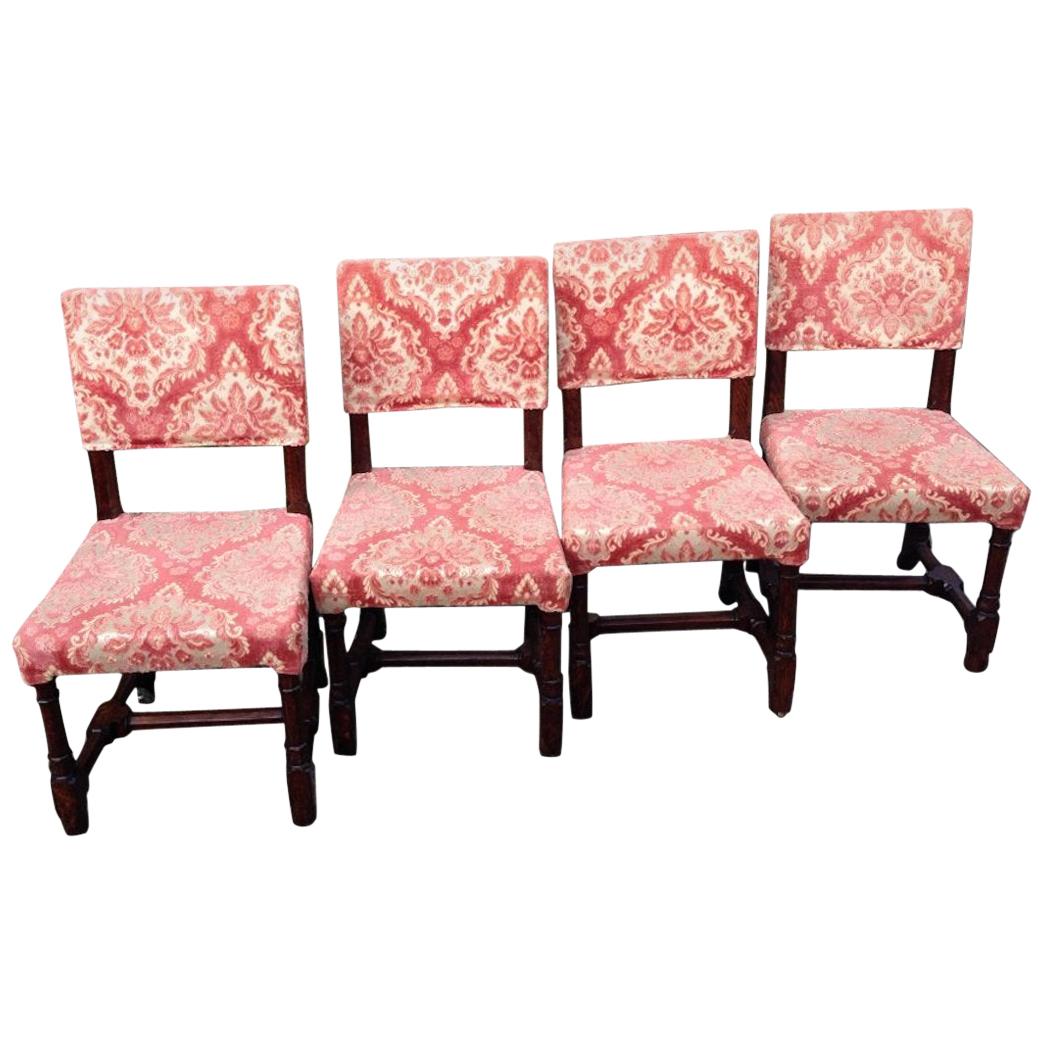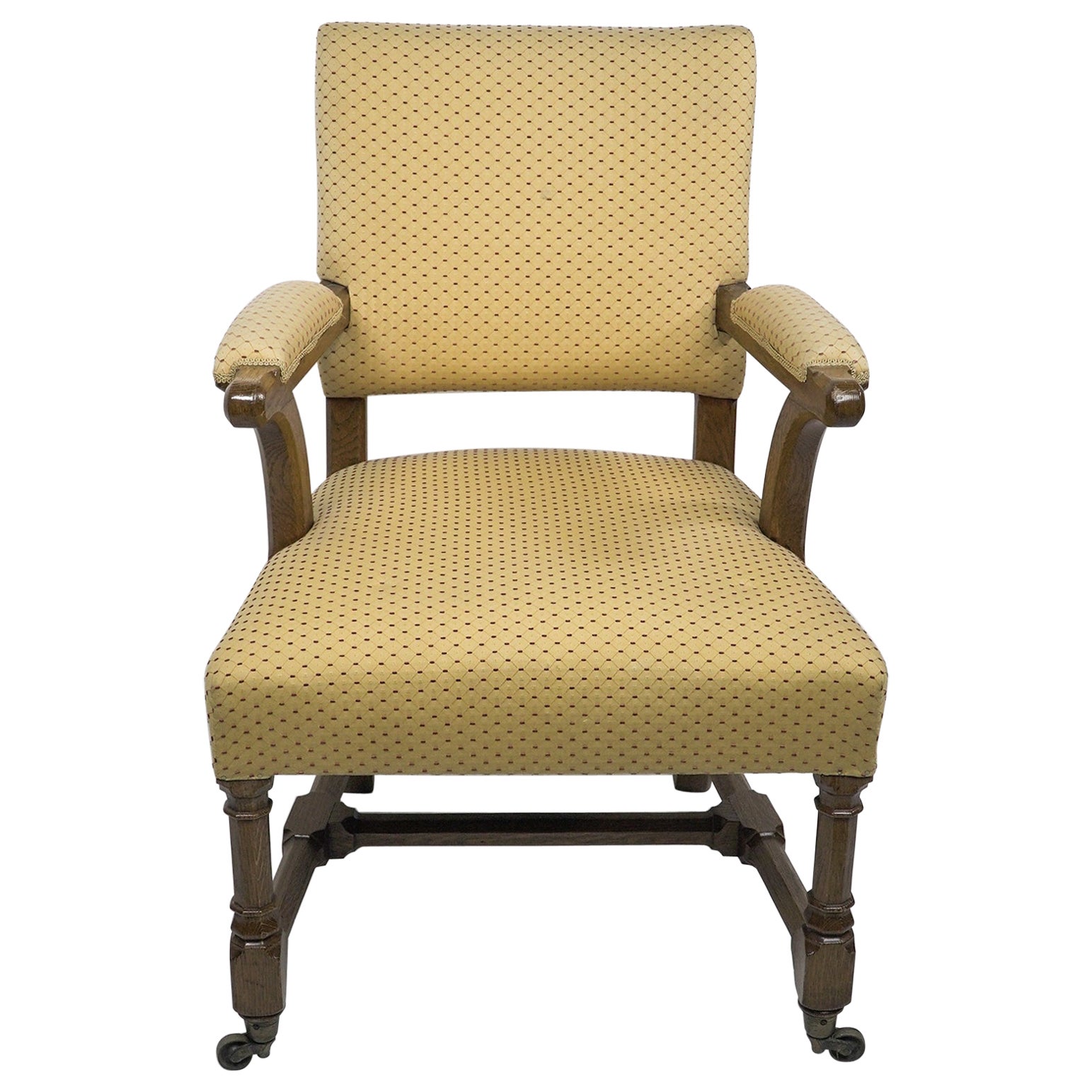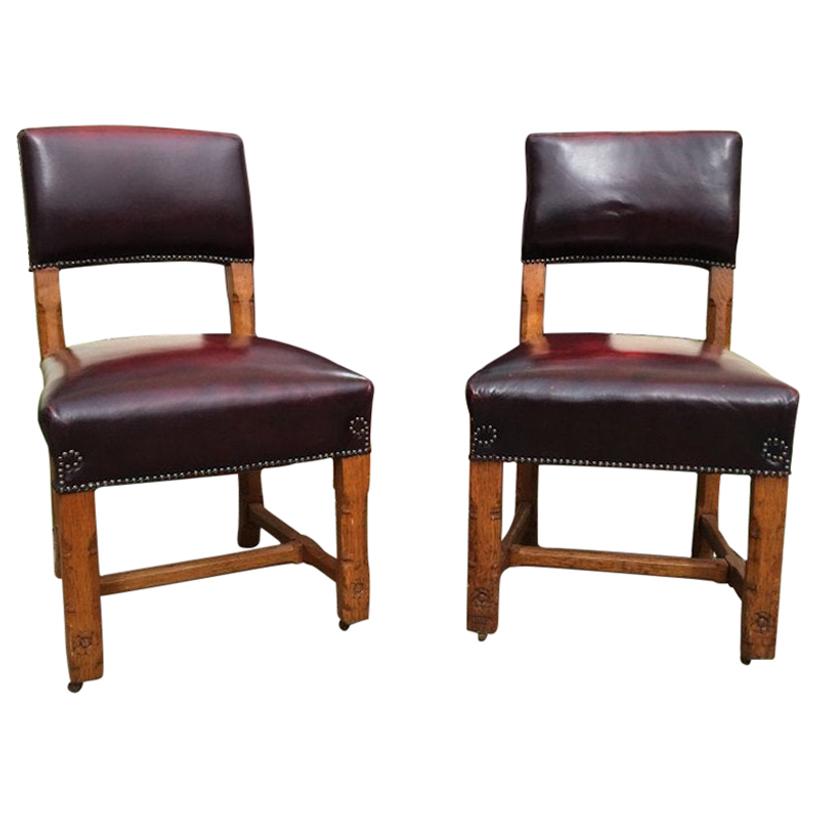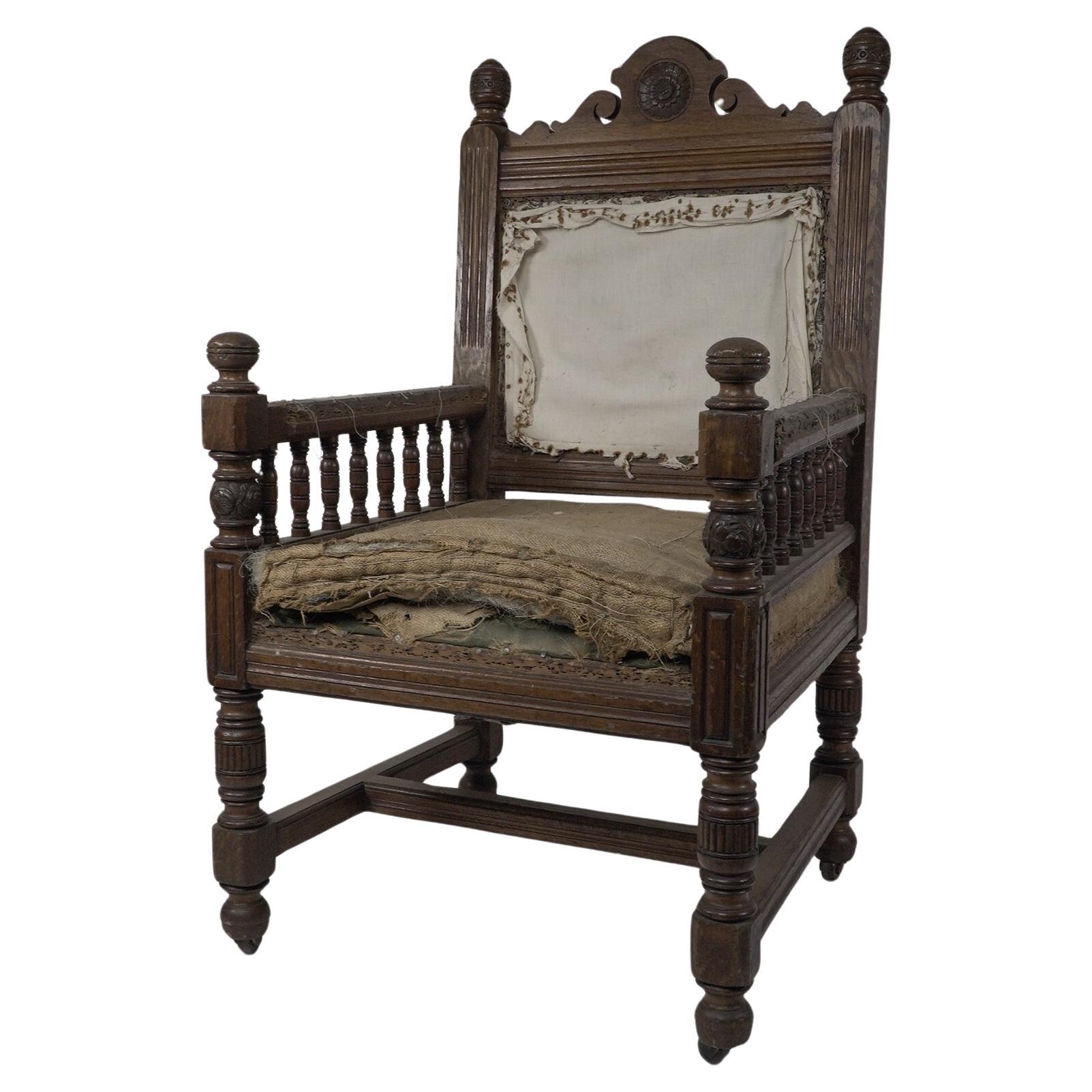A W N Pugin attributed, made by Gillows of Lancaster. A Gothic Revival oak side
About the Item
- Creator:Gillows of Lancaster & London (Maker)
- Attributed to:Augustus Welby Northmore Pugin (Designer)
- Dimensions:Height: 34.45 in (87.5 cm)Width: 16.93 in (43 cm)Depth: 16.93 in (43 cm)Seat Height: 18.9 in (48 cm)
- Style:Gothic Revival (Of the Period)
- Materials and Techniques:
- Place of Origin:
- Period:
- Date of Manufacture:1865
- Condition:Wear consistent with age and use.
- Seller Location:London, GB
- Reference Number:
Gillows of Lancaster & London
It would be difficult to find an antique furniture enthusiast or collector unfamiliar with the name Gillows of Lancaster and London. The British furniture company — which has earned references in the writings of Jane Austen and elsewhere in literature — is renowned for its exceptional quality craftsmanship, and attracted designers such as Thomas Chippendale, Thomas Sheraton and George Hepplewhite in its heyday.
The firm was founded circa 1730 by Robert Gillow (1704–72), who worked as a joiner, housebuilder and overseas merchant before making furniture for homes and export. Gillow established his business in his home city of Lancaster. However, the company later expanded into London in the 1750s after Robert entered into a partnership with his son, Richard, who apprenticed with a London architect and learned the merchant trade in Barbados. Richard had entrepreneurial aptitude — he managed apprenticeships at the firm, ensured that quality materials were a priority, navigated economic hardships, and designed furniture, too. He created seating based on sketches drawn by his cousin, James Gillow, in London.
London’s wealthy upper class took notice of the Gillows’ high-quality furniture, which came to include bedroom furniture, cabinets, a range of seating and other pieces made of rosewood or rich mahogany imported from the West Indies and Jamaica. By the end of the 18th century, the manufacturer was one of the leading furniture makers in Britain. Gillows designed its own furnishings and worked with significant designers; they had in-house upholsterers and cabinetmakers and employed decorative techniques such as “japanning” in their designs.
Gillows of Lancaster and London became Gillow & Co. in 1813 after selling to Redmayne, Whiteside and Ferguson. The company continued to thrive throughout the Georgian era and into the Victorian period, a time that yielded well-known collaborations with Scottish architect and designer Bruce Talbert on a regular basis. High-brow clients of the manufacturer clamored for their inventive and functional designs for tables and writing desks, many of which incorporated whimsical elements such as secret and pop-up drawers. There was also demand for earlier Gillow designs such as Baroque and Gothic Revival pieces as well as adaptations of Chippendale works.
Despite their success, Gillow & Co. entered into financial hardship during the late 1800s with the advent of mass-produced furniture. By 1903, they merged with Waring of Liverpool to become Waring and Gillows and, in 1980, were taken over by Maple & Co. to become Maple, Waring and Gillow. Today, many Gillows of Lancaster and London pieces are in museums throughout the United Kingdom, New Zealand and Australia.
Find antique Gillows of Lancaster and London furniture on 1stDibs.
- ShippingRetrieving quote...Ships From: London, United Kingdom
- Return PolicyA return for this item may be initiated within 3 days of delivery.
- A W N Pugin, probably made by Gillows of Lancaster A Gothic Revival oak armchairBy Gillows of Lancaster & London, Augustus Welby Northmore PuginLocated in London, GBA W N Pugin, probably made by Gillows of Lancaster for the House of Lords London. A Gothic Revival oak armchair with carved rosettes to the headrest, and each side of the arms, and u...Category
Antique 1860s English Gothic Revival Armchairs
MaterialsOak
- A W N Pugin, Stamped Gillows, a Set of Four Gothic Revival Oak Dining ChairsBy Augustus Welby Northmore Pugin, Gillows of Lancaster & LondonLocated in London, GBA W N Pugin, made by Gillows of Lancaster. Stamped Gillows to the back legs. A set of four Gothic Revival oak dining chairs. Measures: Height 34 1/2 inches. x width 17 inches. x d...Category
Antique Mid-19th Century English Gothic Revival Dining Room Chairs
MaterialsOak
- A W N Pugin Gothic Revival oak armchair by Gillows of Lancaster or Holland & SonBy Gillows of Lancaster & London, Augustus Welby Northmore PuginLocated in London, GBA W N Pugin, probably made by Gillows of Lancaster or Holland and son, for the House of Lords in Parliament Square London. A Gothic Revival oak armchair. Professionally re-upholstered.Category
Antique 1860s English Gothic Revival Armchairs
MaterialsOak
- AWN Pugin, Six Gothic Revival Oak Dining Chairs Probably for the House of LordsBy Augustus Welby Northmore Pugin, Gillows of Lancaster & LondonLocated in London, GBA W N Pugin, made by Gillows of Lancaster. Stamped Gillows to the back legs. A set of six Gothic Revival oak dining chairs probably designed for the House of Lords...Category
Antique Mid-19th Century English Gothic Revival Dining Room Chairs
MaterialsOak
- Gillows of Lancaster attri., Gothic Revival Oak Architect's DeskBy Gillows of Lancaster & LondonLocated in London, GBAttributed to Gillows of Lancaster. A rare Gothic Revival architect's folding desk. The top has opposing slides opening to reveal a compartment for storing drawing utensils etc. The ...Category
Antique Late 19th Century English Gothic Revival Desks
MaterialsOak
- AWN Pugin Pair of Gothic Revival Oak Dining Chairs for the Palace of WestminsterBy Augustus Welby Northmore PuginLocated in London, GBA.W.N. Pugin. A unusually large pair of Gothic Revival oak dining chairs with carved florets to the lower front legs and chamfered details to the show wood, probably designed for the Palace of Westminster.Category
Antique Late 19th Century English Gothic Revival Dining Room Chairs
MaterialsOak
- Gillows of Lancaster Regency Rococo Revival Rosewood Side Chairs, circa 1825By Gillows of Lancaster & LondonLocated in Kinderhook, NYAn exquisite set of four English George IV circa 1825 'First' Rococo Revival style side or dining chairs all signed by the legendary cabinetmaking firm Gillows of Lancaster having fo...Category
Antique Early 19th Century English Rococo Revival Dining Room Chairs
MaterialsCane, Rosewood
- SIX GILLOWS OF LANCASTER ATTRIBUTED ANTIQUE HARDWOOD REGENCY 1810 DINING CHAIRsBy Gillows of Lancaster & LondonLocated in GBRoyal House Antiques We are delighted to offer this important suite of museum quality, antique Colonial Gillows of Lancaster Attributed solid Rosewood dining chairs with ornately carved back splats Please note the delivery fee listed is just a guide and covers London only for the UK and local Europe for the rest of the world, if you are outside of this area please send me your address and I will provide you with an accurate quote Where to begin, if you’re looking at this listing then the chances are you know exactly how significant this suite is, Gillows of Lancaster & London was simply put, one of the most important furniture designers in the history of England, these chairs are the only Colonial examples I have ever seen and in Rosewood no less, they weigh roughly three times more than a standard dining chair of the same style and size, they are very substantial The chairs early 19th century circa 1810-1820, the carving is exquisitely executed and the chairs look sophisticated and elegant from all angles The suite has been sympathetically restored to include a deep clean, hand condition wax and hand polish, the seat covers have been left as they are, they are fine, the timber has a wonderfully aged patina that is honestly sublime Dimensions Height:- 81cm Width:- 45cm Depth:- 50cm Seat height:- 44cm Please note all measurements are taken at the widest point. Lot Essay These chairs are closely related to those in two recognised Chippendale commissions: Sir Gilbert Heathcote (d. 1785), 3rd Baronet for Normanton Hall, Rutland and William Crichton-Dalrymple, 5th Earl of Dumfries (4th Earl of Stair, 1699-1768) for Dumfries House, Ayrshire. THE RELATED CHAIRS The chairs are of identical decoration to the set of two armchairs and ten single chairs, circa 1765, formerly at Normanton Hall (1). In 1759, Sir Gilbert Heathcote (d. 1785), 3rd Baronet, succeeded to the vast inheritance established by his grandfather, also Gilbert, 1st Baronet (1652-1733), who was reputed to be ‘the richest commoner in England’ (2). The 3rd Baronet employed both Chippendale Senior and his son, Chippendale Junior, in the furnishing of his Palladian mansion, Normanton Hall in Rutland, and his London houses, 29 Grosvenor Square, London and Browne's House at North End, Fulham. Surviving Chippendale accounts, although incomplete, show that the firm was working periodically for members of the Heathcote family from 1768 to 1821. Most of the furniture listed in these accounts was intended for Browne’s House, although after 1798 when the family relinquished this residence some of the furniture was moved to Normanton Hall. The latter was sold in 1924, and any furniture not included in the Normanton Hall sale was taken to the Earl of Ancaster’s seat at Grimsthorpe Castle, Lincolnshire. Chippendale’s earliest invoice for Sir Gilbert Heathcote records the acquisition in 1768 of ‘6 India Back and arm chairs Japand to imitate the Bamboe’, signifying how the family embraced the highly fashionable chinoiserie taste. Although the Normanton chairs cannot be conclusively identified in the extant Chippendale accounts, their form and ornamentation led Christopher Gilbert to suggest that they were possibly by Chippendale (3). The set of four mahogany chairs at Dumfries House have nearly-identical pagoda-form cresting rails and identical terminals but differ in the arrangement of the 'Chinese' paling in the backs and side panels. Although no documentary evidence for the Dumfries chairs survives, in their execution and sophisticated carving of the toprails, they are extremely close to Chippendale’s hand. Another near-set of closely related chairs is at Saltram House, Devon, where Chippendale worked between 1771-2; these dates are based on payments in John Parker's cash account book, and probably do not reflect a true picture of the entire commission as Parker often paid tradesmen by banker's draft (4). Comprising two armchairs and seven single chairs, this set, circa 1765, is made of padouk, and has been described by the National Trust as ‘Chinese Export’ (5). The set was returned to Saltram in 1951 having been accepted by H.M. Treasury in lieu of full payment of Death Duty from the Executors of Edmund Robert Parker, 4th Earl of Morley (1877-1951). Some of the chairs are currently on display in ‘The Chinese Chippendale Bedroom’. A further set of four padouk chairs of the Saltram pattern was almost certainly at Kenwood House, London; some of these are recorded in 18th century inventories drawn up by Lord Mansfield. This set was removed to Scone Palace, Perth, prior to the auction at Kenwood in 1922, and subsequently sold from ‘Scone Palace and Blairquhan: The Selected Contents of Two Great Scottish Houses’, Christie’s, London, 24 May 2007, lot 298. Another pair of padouk chairs of this model sold ‘The Collection of Peggy and David Rockefeller’, Christie’s, New York, 10 May 2018, lot 647 ($193,750 inc. premium). THE DESIGN Conceived in the Chinese manner expounded by William and John Halfpenny in Rural Architecture in the Chinese Taste (1752), and Sir William Chambers in his Designs of Chinese Buildings, Furniture, Dresses, Machines and Utensils (1757), the pattern for this set of ‘Pagoda’ chairs relates to nine designs for ‘Chinese Chairs’ in the 1st edition of Chippendale’s Director (1754); the cabinet-maker describes these designs thus: Plates XXIII, XXIV and XXV are nine Chairs in the present Chinese manner, which I hope will improve that taste, or manner of work; it having yet never arrived to any perfection; doubtless it might be lost without feeling its beauty: as it admits of the greatest variety, I think it the most useful of any other. The sizes are all specified on the designs. The three last (No. XXV.) I hope will be well received, as there has been none like them yet made. The Georgian period witnessed the proliferation of such railed and pagoda-crested chairs in both the ‘picturesque’ Chinese tea pavilions of landscaped parks as well as in fashionable apartments hung with ‘India’ paper. The geometric ‘Chinese’ feet of these chairs are also found on a set of pedestals...Category
Antique 1810s English George III Dining Room Chairs
MaterialsHardwood
- English Oak Gothic Style Curule Armchairs Attributed to A.W.N. Pugin, circa 1830By Augustus Welby Northmore PuginLocated in Kinderhook, NYEnglish late Regency period circa 1830 'Gothic' style armchairs of curule form having solid oak chamfer edge frames, the rectangular (upholstered) backs connecting padded-rest arms c...Category
Antique Early 19th Century English Gothic Revival Armchairs
MaterialsUpholstery, Oak
- Pair of Regency Mahogany Hall Chairs by Gillows of LancasterBy Gillows of Lancaster & LondonLocated in London, GBA PAIR OF REGENCY MAHOGANY HALL CHAIRS ATTRIBUTED TO GILLOWS, c. 1815 For a related mahogany hall chair see Susan E Stuart, Gillows of LANCASTER and LONDON 1730-1840, Antique Coll...Category
Antique Early 19th Century English Regency Chairs
MaterialsMahogany
- English Gothic Revival Leather Side ChairsLocated in New York, NYSet of 11 English Gothic Revival style (19th Century) oak side panel back side chairs with finials and gray leather seats.Category
Antique 19th Century English Gothic Revival Dining Room Chairs
MaterialsLeather, Oak
- Unique Set of Four Walnut Framed Dining Chairs by Gillows of LancasterBy Gillows of Lancaster & LondonLocated in Crawley, GBFor sale a set of four Victorian walnut framed dining chairs by Gillow of Lancaster , raised on fluted tapering legs , bearing stamped maker s marks to seat rails. According to Wikip...Category
Antique 1850s British Victorian Dining Room Chairs
MaterialsWalnut






